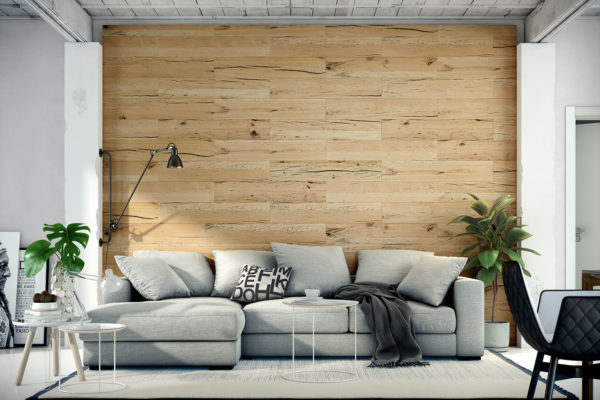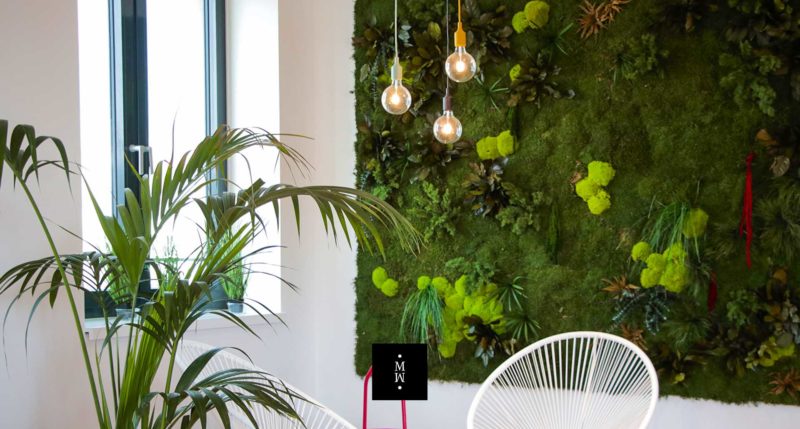The challenge of interior design
Walls play an important role in shaping the character of rooms and buildings. More and more often, biomaterials and sustainable wall coverings are being used for natural interior design. At the same time, the materials used should not simply be decorative. The requirements for interiors have changed fundamentally over the years. Particularly in offices and medical practices, interior designers are faced with new, major challenges in meeting the demands of users. They are increasingly relying on raw materials and materials that provide additional added value. Natural wall coverings are wonderfully suitable for this.
Special properties characterise natural materials
The use of natural products such as felt, wood, cork or moss for wall cladding improves, depending on the application, e.g. the acoustics and the room climate. The materials are easy to care for, low in pollutants and extremely versatile. Complete room concepts can be implemented with natural raw materials. At the same time, you make a contribution to the environment – many materials are now produced and installed in an extremely sustainable and resource-saving way.
We present 5 of the most beautiful materials and explain which advantages and disadvantages there are.
Wood
The classic among wall coverings has a long tradition. Raw wooden walls have characterised interiors for a long time in the course of human history. And who doesn’t remember high, slightly musty-smelling rooms that seemed heavy, gloomy and spooky due to dark wood panelling. Grandma’s wooden panels from the 70s have long since had their day – wood is once again being used in more versatile ways than ever.
Advantages:
- Warm, natural look
- Unique structure and feel
- Easy to process
- Creates a pleasant room climate
Disadvantages:
- Wood “works” and changes, noises are normal
- higher-maintenance
- Must not be permanently exposed to moisture
- not fireproof
Stone
Wall cladding made of stone has also been used for a very long time, or has been a component of human construction since time immemorial. One should by no means think only of the simple fieldstone dwellings. Noble materials such as granite and marble were used in architecture early on. Today, the trend is primarily back to natural stone walls, bricks in industrial design or slate slabs for an urban look.
Advantages:
- Break-proof and waterproof -> perfectly suitable for showers, bathrooms and other damp rooms
- Fireproof and non-combustible
- Good heat storage capacity
- Three-dimensionality gives the room depth
Disadvantages:
- Testing and preparation of the substrate requires expertise
- quite expensive
- Not suitable for all wall constructions due to its high dead weight
- difficult realisation of colour combinations
Cork
70 per cent of the world’s cork harvest is later used to make closures for wine and champagne bottles. Everyone knows the “cork”. Soles for slippers are also often made from cork. In the building materials industry, on the other hand, the material is more of a niche product – partly because the limited availability of the raw material is comparatively expensive. In the living area, cork is mainly known as a material for floor coverings. Nevertheless, unique wall designs can be realised, as cork can be used wafer-thin as wallpaper.
Advantages:
- Extremely light
- Very thin – can even be used as wallpaper
- Robust and extremely resilient
- Many design variations possible
Disadvantages:
- quite cost-intensive
- not fireproof
- only conditionally suitable for damp rooms
- can fade if exposed to too much UV radiation
- Processing requires specialist knowledge
- grows back very slowly
Moss
Moss is a fascinating alternative to hydroponics in the field of indoor greening. Properly prepared, it requires neither light, irrigation nor fertilisation. Moreover, there are no additional costs for the maintenance of this evergreen wall design. A natural wall covering of moss and plants contributes to an extremely calm room climate. It feels like you are sitting in the forest on a sunny day. Impressive moss walls in any size are a guarantee for attention and create a high recognition value. Moss wall coverings increase the feel-good factor in a room and have been proven to lower stress levels. Here we present our mosses in detail.
Advantages
- Absorbs sound by up to 60%
- Lively natural look with many design options
- Almost maintenance free
- Improves the indoor climate
- Suitable for allergy sufferers
Disadvantages
- No two walls are alike – reproducibility almost impossible
- Production process is more complex
As you can see, nature offers a multitude of beautiful possibilities and materials to make interiors eco-friendly and sustainable. Our goal at Moos Moss is to take your living and working spaces to a whole new level with our moss walls, so you can be relaxed, focused and creative. We bring you the most beautiful feelings, which you otherwise only feel in the forest, directly to your walls and ceiling.
Let´s make the world a little bit greener






